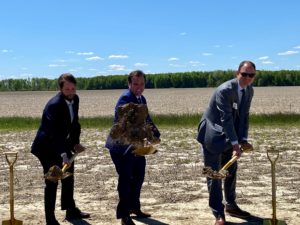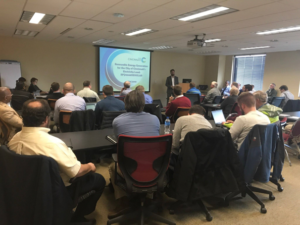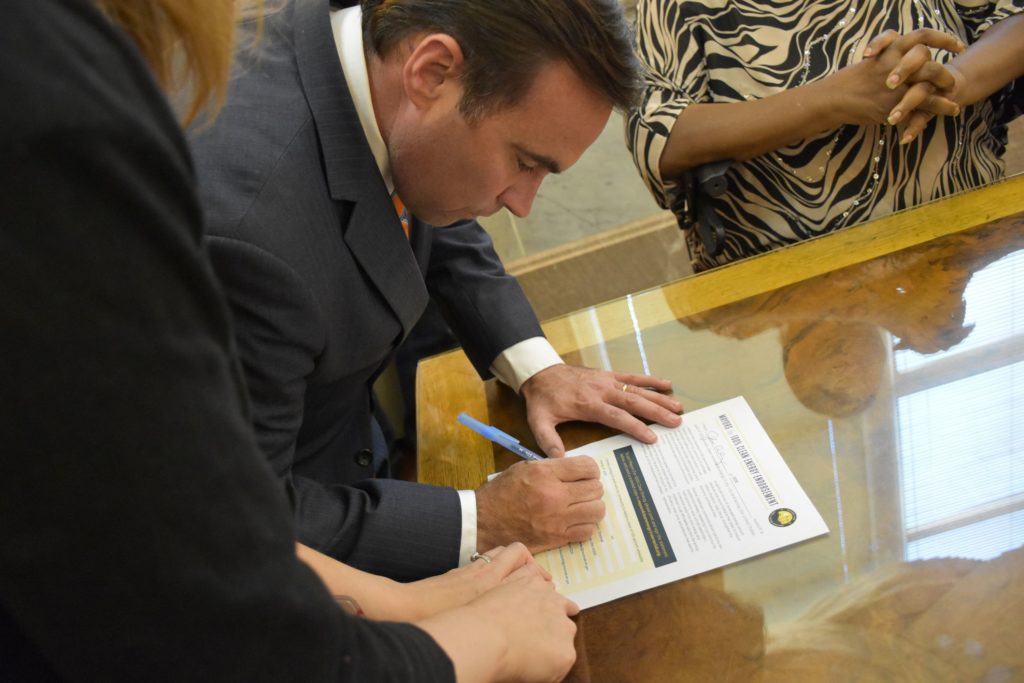Local Government:
City of Cincinnati, OhioProject:
New Market Solar FarmCategory:
Off-Site Physical PPAProject Purpose
To build a 100 megawatt (MW) solar array that will provide renewable energy for municipal facilities and city residents, support workforce development, and advance Cincinnati’s long-term goal to transition to 100 percent renewable energy community-wide by 2035.
Project Overview

In November 2019, Cincinnati Mayor John Cranley announced a signed deal with Creekwood Energy and Hecate Energy to build a 100 MW solar array, the New Market Solar Farm, to generate clean electricity for both City operations and residential households. In September 2020, the last components of the project were finalized when the City executed a contract with energy supplier Dynegy to deliver the residential portion of the energy generated to customers through the Cincinnati Electric Aggregation Program.
This project is the culmination of a multiyear effort, first envisioned and championed by the Mayor in 2017. Once constructed—about 40 miles east of downtown in Highland County—the project will be one of the largest city-led solar installations in the country. In May 2021, the City officially broke ground on the array.
The City, which incurred no up-front costs to construct the 100 MW array, will buy 35 MW of the energy generated at a fixed rate that is locked in for 20 years through an off-site physical power purchase agreement. This is enough to power 30 percent of municipal operations. The 20-year contract provides a hedge against future electricity price increases and is expected to save the City approximately $1.7 million total over the contract term. The other 65 MW generated by the array will go to Cincinnati residents at a discounted rate through the Cincinnati Electric Aggregation Program.
“Cities need to take action—and that’s exactly what Cincinnati is doing. We are spending money we would already spend on power to buy lower-cost renewable energy that also benefits the community.”
Cincinnati Mayor John Cranley
Demonstrating that renewable energy projects can deliver essential community benefits beyond just clean electricity, the Cincinnati City Council also sought for the project to provide job opportunities for residents. To achieve this, the City partnered with a local technical and community college, Cincinnati State, and a local union chapter, IBEW 212, to integrate a workforce development and hiring program into the project.
The full 100 MW solar array is expected to be operational by the end of 2021. Its 310,000 solar panels will cover an area the size of 750 football fields. Collectively, the array will reduce annual carbon emissions in the region by 158,000 tons, which is the equivalent of removing 30,000 cars from the road or planting 2.4 million trees each year.
For a more detailed overview of this deal, check out the Renewables Accelerator’s case study about it, Cincinnati’s Path to a 100 MW Solar Deal.
What were Cincinnati’s biggest challenges in setting up this project?
Developing internal knowledge: Many City staff lacked important knowledge and had to learn the fundamentals of energy markets and available renewable energy options. To address this, the City sought out external partners, including the American Cities Climate Challenge Renewables Accelerator, to train its staff and provide technical assistance throughout the process. This ongoing support from others helped fill in knowledge gaps for City personnel, many of whom were already stretched and managing competing priorities.

Managing project team dynamics: As the project advanced, the project team expanded substantially to include many external partners, all of whom had their own distinct perspectives on project details. Managing these different interests made coordination more complicated and challenging for the City’s core team. As a result, City staff had to adapt and play a central mediating role to align the parties, seek resolutions, and push the process forward.
Overcoming internal hesitance: While the project had strong support from several key City staff and elected officials, particularly the Mayor, it was also met with some skepticism and concern from some important City Administrators throughout its development. People worried about whether the project might increase the City’s energy costs, disrupt ongoing operations, take away time from other City priorities, or not ultimately succeed.
To address these concerns, the mayor and other political leaders needed to actively express continued support for the project and its overall vision, and proponents had to appeal to varied interests by emphasizing the different types of project benefits to encourage support. In addition, the core team had to conduct detailed analysis and scenario planning in order to counter people’s reservations. In the end, though, the efforts paid off and created universal support for the project from all elected City leaders, a rare occurrence in Cincinnati (and many other city governments).
Dealing with unexpected circumstances: Late in the process, just before the contract award was made, the City Council unexpectedly added a new condition, requiring that any contractor used for the project have a project-labor agreement in place. This created initial delays as the City’s team engaged in negotiations with labor unions on hiring and workforce elements of the project. However, the result was a positive project co-benefit involving the integration of a workforce development and hiring program that put Cincinnati residents to work on the project. In the end, the conditions made the project stronger and better for the local workforce.
What advice would Cincinnati give other local governments as they pursue climate action projects?
Engage with the utility: Regardless of a project’s structure and how much it might involve a city’s utility, the utility is a stakeholder in the process, particularly on the matter of distribution. It is important to engage with a city’s utility early on in the process, and to do so in a respectful and transparent manner. This helps address any potential issues and get aligned on project plans and logistics.
Develop decision maker buy-in: It is critical to have senior-level city leadership fully on board and committed to a project, especially at the executive level, and to continue engaging with them throughout the process. Developing strong buy-in is time consuming, but it is both necessary and helpful to a project’s long-term prospects and outcomes.

Seek assistance when needed: A city does not need to know every detail about a potential renewable energy project in order to move forward. When questions or challenges arise, seek out support and assistance from experienced partners and technical advisors, both internal and external. This will help increase overall team capacity, fill in knowledge gaps of city staff, and ensure things are being done correctly and optimally for all project components.
Continue to refine the project as needed: Throughout the process, new information will arise and project requirements may evolve. Take the time to collect and integrate new information, feedback, and any revised requirements. Doing so will produce a better final project. The solicitation period is a particularly good stage for collecting feedback that can help a city revise and shape a project based on the interactions with and questions posed by those responding to a request for proposals.
“Cincinnati was selected as a winner in the American Cities Climate Challenge because of Mayor Cranley’s commitment to ambitious and impactful climate solutions—solutions which not only reduce carbon emissions, but also protect public health and create jobs. This offsite renewable deal is the latest example of Cincinnati’s ambition turned into achievement. Cincinnati is showing how cities are leading the way to our clean energy future and paving the way for others in the region to follow suit.”
Antha Williams, Head of Environmental Programs at Bloomberg Philanthropies
How does this project fit into Cincinnati’s broader climate and community goals?

In July 2017, Mayor Cranley and the City Council passed a motion to update the Green Cincinnati Plan, first adopted in 2008. The updated plan was developed in partnership with government, corporate, academic, nonprofit, faith, and community organizations. It presents a comprehensive set of 80 recommended strategies—across energy, buildings, transportation, natural systems, and more—to advance a more sustainable, equitable, and resilient future for Cincinnati. This includes a pathway for achieving 100 percent renewable energy by 2035 and reducing Cincinnati’s total carbon emissions 80 percent by 2050. The updated plan was adopted in May 2018.
The impetus for this project grew out of the effort and objectives behind updating the Green Cincinnati Plan. Partially in response to the United States’ decision to withdraw from the Paris Agreement, in 2017 Mayor Cranley began to champion a vision of powering Cincinnati with solar energy. A large-scale solar project was a central component of the updated Green Cincinnati Plan. A few months after the updated plan was adopted, the mayor signed on to the Sierra Club’s Ready for 100 campaign, committing Cincinnati to achieving 100 percent community-wide renewable energy by 2035.
This project advances renewable energy and carbon emissions reduction goals for both City operations and Cincinnati as a whole. The clean electricity generated by this project will power 30 percent of City operations and at least 8 percent of residential usage.
Additional Information and Resources

- Cincinnati to Construct Nation’s Largest City-Led Solar Project (City of Cincinnati press release)
- Cincinnati’s Path to a 100 MW Solar Deal (Renewables Accelerator case study)
- Cincinnati to Build Nation’s Largest City-Led Solar Array (News article)
- Cincinnati Electric Aggregation Program (City of Cincinnati program)
- Green Cincinnati Plan (City of Cincinnati plan)
- New Market Solar Farm (Hecate’s website for the solar farm)
- Ready for 100 (Sierra Club campaign)
- Cincinnati Becomes 100th US City Committed to 100 Percent Clean, Renewable Energy (Sierra Club press release)
- Off-Site Physical PPA (Renewables Accelerator’s guidance for this type of procurement)
The City of Cincinnati received technical assistance from the American Cities Climate Challenge Renewables Accelerator on this project. This project was included on the Renewables Accelerator’s list: 10 of the Most Noteworthy Local Government Renewables Deals of 2020.
